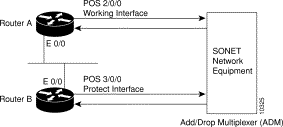Synchronous optical network and synchronous digital hierarchy are transport technologies that are used to transmit synchronously large amount of data across relatively long distances using fibre optics links that form the backbone of communication networks. For shorter distances SONET can use copper links. SONET is used in America and SDH is used everywhere else in the world.
The frame format used by SONET is the synchronous transport signal with a base level signal of STS-1 at 51.84 Mbps. The frame format used by SDH is synchronous transport module with a base level signal of STM-1 at 155.52 Mbps.
SONET/SDH rate multiplier is 4 and every higher bandwidth connection is 4 times faster than the one before with a bandwidth limit of up to 40Gbps.
SONET basic transmission frame is STS-1, consisting of 9 rows by 90 columns with the total size of 810 bytes. A single SONET STS-1 frame is transmitted in 125µs or 8000 frames per second. 8000 fps * 810 B/frame = 51.84 Mbps. SONET frame includes various overhead bytes ( 3 bytes/row ) and an envelope capacity for transporting payloads.
SDH basic transmission frame is STM-1, consisting of 9 rows by 270 columns with a total size of 2430 bytes. STM-1 frames are also transmitted in 125µs or 8000 frames per second. 8000 * 2430B/frame = 155.52 Mbps. As with SONET, SDH frames also have various overhead bytes ( 9 bytes/row) and 261 bytes for information payload.
Transport Hierarchy
SONET standard includes for functional layers, photonic, path, line and section, SONET layers correspond to the physical and data-link layers of the OSI Model.
Path:
At this layer the payload is mapped and de-mapped into SONET frames. It is where path terminating equipment interfaces with non-SONET equipment with the SONET network. This layer is responsible for moving the optical signal from source to destination.
Line:
Line terminating equipment (LTE) originates or terminates one or more sections of the line signal. LTE does the synchronisation and multiplexing of SONET frames. STS multiplexers and Add/Drop multiplexers provide line layer functions.
Section:
A section is a single fibre cable run that can be terminated by any network element (line, path or optical regenerator). Section layer is responsible for formatting SONET frames and convert electrical signals into optical signals. Section Terminating Equipment (STE) can originate, access, modify, or terminate the section header overhead. The first 3 bytes of a STS-1 frame row compromise the section and line overhead.
Photonic:
This layer corresponds to the physical layer of the OSI Model. It includes physical specifications the optical fibre channel.
SONET Network equipment
E-O-E regenerators are used to regenerate signals that travel long distances. The most effective way to regenerate although not necessarily is to convert to the electrical domain and then to the optical domain.
ADM, add-drop multiplexers are the most versatile pieces of SONET networking, as they can add or drop any amount of traffic, ADMs are used to create SONET transport networks consisting of SONET rings and point-to-point connections.
TM, terminal multiplexers are used to aggregate lower-bandwidth traffic into higher-bandwidth SONET pieces for transmission over optical fibres.
SONET Architecture
Configuring POS on Cisco routers
POS interfaces provide data transmission over SONET and SDH frames using cisco HDLC and PPP.
! interface POS1/0 ip address 192.168.1.1 255.255.255.254 encapsulation ppp keepalive 5 crc 32 !

router#configure terminal router(config)#interface loopback 1 router(config-if)#ip address 7.7.7.7 255.255.255.0 router(config)#interface pos 2/0/0 router(config-if)#aps group 1 router(config-if)#aps working 1 router(config-if)#pos ais-shut router(config-if)#end router#
Router B
router#configure terminal router(config)#interface loopback 2 router(config-if)#ip address 7.7.7.6 255.255.255.0 router(config)#interface pos 3/0/0 router(config-if)#aps group 1 router(config-if)#aps protect 1 7.7.7.7 router(config-if)#pos ais-shut router(config-if)#end router#


No comments:
Post a Comment